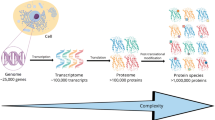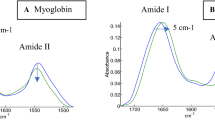Abstract
We describe a simple approach to classify amino acid residue types in NMR spectra of proteins for supporting the backbone resonance assignments. It makes use of the differences in biosynthetic pathways of the 20 amino acids in Escherichia coli. Therefore, it is distinct from the parameters routinely exploited in the backbone resonance assignment such as chemical shifts and spin topology information. The combination of biosynthetically directed fractional 13C-labeling and uniform 15N-labeling enables us to obtain both residue-type specific information and sequential connectivities from a single protein sample. The residue-type classification exploiting biosynthetic pathways can be used for accelerating the conventional backbone assignment procedure.





Similar content being viewed by others
References
Clore GM, Gronenborn AM (1994) Multidimensional heteronuclear nuclear-magnetic-resonance of proteins. Methods Enzymol 239:349–363
Dötsch V, Oswald RE, Wagner G (1996a) Amino-acid-type-selective triple-resonance experiments. J Magn Reson B 110:107–111
Dötsch V, Oswald RE, Wagner G (1996b) Selective identification of threonine, valine, and isoleucine sequential connectivities with a TVI-CBCACONH experiment. J Magn Reson B 110:304–308
Fiaux J, Andersson CIJ, Holmberg N, Bülow L, Kallio PT, Bailey JE, Szyperski T, Wüthrich K (1999) C-13 NMR flux ratio analysis of Escherichia coli central carbon metabolism in microaerobic bioprocesses. J Am Chem Soc 121:1407–1408
Fiaux J, Cakar ZP, Sonderegger M, Wüthrich K, Szyperski T, Sauer U (2003) Metabolic-flux profiling of the yeasts Saccharomyces cerevisiae and Pichia stipitis. Eukaryot Cell 2:170–180
Fischer E, Sauer U (2003) Metabolic flux profiling of Escherichia coli mutants in central carbon metabolism using GC-MS. Eur J Biochem 270:880–891
Grzesiek S, Bax A (1992) Improved 3D triple-resonance NMR techniques applied to a 31-Kda protein. J Magn Reson 96:432–440
Iwai H, Forrer P, Plückthun A, Güntert P (2004) Letter to the editor: assignments of H-1 and N-15 resonances of the bacteriophage lambda capsid stabilizing protein gpD. J Biomol NMR 28:89–90
Luginbühl P, Pervushin KV, Iwai H, Wüthrich K (1997) Anisotropic molecular rotational diffusion in N-15 spin relaxation studies of protein mobility. Biochemistry 36:7305–7312
Maaheimo H, Fiaux J, Cakar ZP, Bailey JE, Sauer U, Szyperski T (2001) Central carbon metabolism of Saccharomyces cerevisiae explored by biosynthetic fractional C-13 labeling of common amino acids. Eur J Biochem 268:2464–2479
McIntosh LP, Dahlquist FW (1990) Biosynthetic incorporation of N-15 and C-13 for assignment and interpretation of nuclear-magnetic-resonance spectra of proteins. Q Rev Biophys 23:1–38
Muchmore DC, McIntosh LP, Russell CB, Anderson DE, Dahlquist FW (1989) Expression and N-15 labeling of proteins for proton and N-15 nuclear-magnetic-resonance. Methods Enzymol 177:44–73
Neidhardt FC, Curtiss R, Ingraham JL, Lin ECC, Low KB, Magasanik B, Reznokoff WS, Riley M, Schaechter M, Umbarger HE (eds) (1996) Escherichia coli and Salmonella typhimurium, vol. 1, American Society for Microbiology Press, Washington
Neri D, Szyperski T, Otting G, Senn H, Wüthrich K (1989) Stereospecific nuclear magnetic-resonance assignments of the methyl-groups of valine and leucine in the DNA-binding domain of the 434-repressor by biosynthetically directed fractional C-13 labeling. Biochemistry 28:7510–7516
Neri D, Otting G, Wütrich K (1990) H-1 and C-13 NMR chemical-shifts of the diastereotopic methyl-groups of valyl and leucyl residues in peptides and proteins. Tetrahedron 46:3287–3296
Sauer U, Hatzimanikatis V, Bailey JE, Hochuli M, Szyperski T, Wüthrich K (1997) Metabolic fluxes in riboflavin-producing Bacillus subtilis. Nature Biotechnol 15:448–452
Sauer U, Lasko DR, Fiaux J, Hochuli M, Glaser RW, Szyperski T, Wüthrich K, Bailey JE (1999) Metabolic flux ratio analysis of genetic and environmental modulations of Escherichia coli central carbon metabolism. J Bacteriol 181:6679–6688
Schubert M, Smalla M, Schmiede P, Oschkinat H (1999) Music in triple-resonance experiments: amino acid type-selective H-1-N-15 correlations. J Magn Reson 141:34–43
Senn H, Werner B, Messerle BA, Weber C, Traber R, Wüthrich K (1989) Stereospecific assignment of the methyl H-1-NMR lines of valine and leucine in polypeptides by nonrandom C-13 labeling. FEBS Lett 249:113–118
Sola A, Maaheimo H, Ylonen K, Ferrer P, Szyperski T (2004) Amino acid biosynthesis and metabolic flux profiling of Pichia pastoris. Eur J Biochem 271:2462–2470
Szyperski T, Güntert P, Otting G, Wüthrich K (1992a) Determination of scalar coupling-constants by inverse fourier transformation of in-phase multiplets. J Magn Reson 99:552–560
Szyperski T, Neri D, Leiting B, Otting G, Wüthrich K (1992b) Support of H-1-NMR assignments in proteins by biosynthetically directed fractional C-13-labeling. J Biomol NMR 2:323–334
Szyperski T (1995) Biosynthetically directed fractional C-13-labeling of proteinogenic amino-acids – an efficient analytical tool to investigate intermediary metabolism. Eur J Biochem 232:433–448
Yamazaki T, Otomo T, Oda N, Kyogoku Y, Uegaki K, Ito N, Ishino Y, Nakamura H (1998) Segmental isotope labeling for protein NMR using peptide splicing. J Am Chem Soc 120:5591–5592
Wüthrich K (1986) NMR of Proteins and Nucleic Acids. Wiley, New York, NY, USA
Züger S, Iwai H (2005) Intein-based biosynthetic incorporation of unlabeled protein tags into isotopically labeled proteins for NMR studies. Nat Biotechnol 23:736–740
Acknowledgments
The authors thank Sara Züger, Dalibor Hrstka, and Katja Karjalainen for the preparation of the samples. This work is supported by the Academy of Finland and by the Biocentrum Helsinki. JF gratefully acknowledges support from the Human Science Frontier Program.
Author information
Authors and Affiliations
Corresponding author
Electronic supplementary material
A table ofsIvalues measured for the samples of 434(1–63) produced under different culture conditions
Rights and permissions
About this article
Cite this article
Iwai, H., Fiaux, J. Use of biosynthetic fractional 13C-labeling for backbone NMR assignment of proteins. J Biomol NMR 37, 187–193 (2007). https://doi.org/10.1007/s10858-006-9124-8
Received:
Accepted:
Published:
Issue Date:
DOI: https://doi.org/10.1007/s10858-006-9124-8




